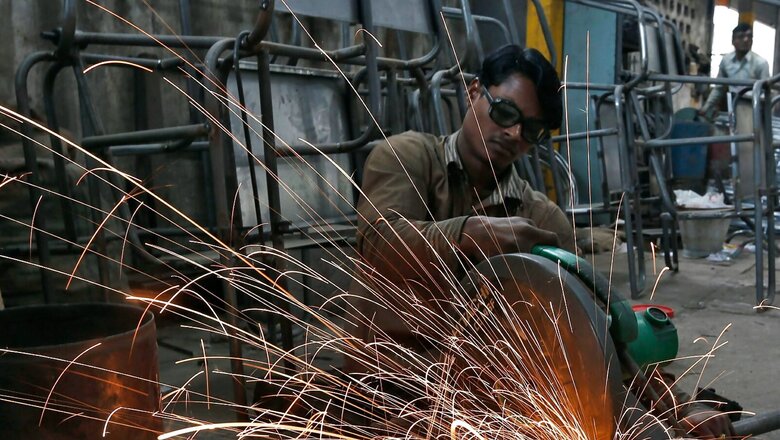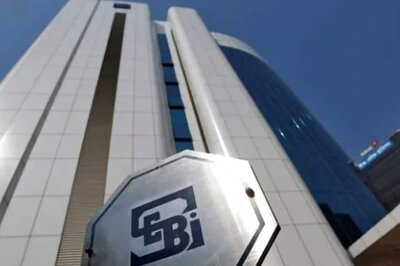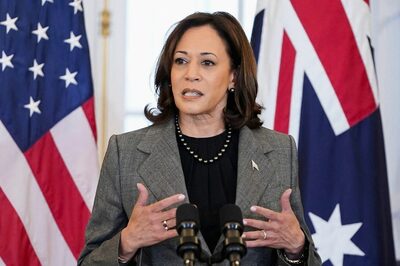
views
It promises to be a brighter Diwali for Indians as the economy shows signs of bouncing back from the pandemic low, the revival reflecting in upbeat projections by global financial institutions, increased factory output, a bullish stock market, blockbuster IPOs, decline in unemployment rate, increasing foreign investment and easing inflation.
The Finance Ministry’s Monthly Economic Review credits the revival to strategic reforms and the pace of Covid-19 vaccination drive in the country. “India is well-placed on the path to swift recovery with growth impulses visibly transmitted to all sectors of the economy… Strategic reforms undertaken so far along with new milestones in vaccination drive have enabled the economy to navigate the ravaging waves of the Covid-19 pandemic,” it said.
As per global projections, India will retain the tag of the fastest-growing economy in 2022. Here’s a closer look at factors that are key in keeping India north of the projections:
Positive Global Outlook
Global institutions such as the World Bank and the International Monetary Fund (IMF) have welcomed India’s gradual climb out of the pandemic slump, while ratings agency Moody’s upgraded India’s outlook from ‘negative’ to ‘stable’.
As per the IMF’s flagship World Economic Outlook (WEO), the Indian economy, which contracted by 7.3% due to the pandemic, is likely to grow by 9.5% in 2021 and 8.5% in 2022. In contrast, the United States is projected to grow at 6% this year and 5.2% the next year. China, on the other hand, the IMF said, is projected to grow at 8% in 2021 and 5.6% in 2022.
Briefing reporters at the release of the WEO report, Chief Economist of the IMF Gita Gopinath acknowledged that India has emerged from a “very tough second wave” of Covid-19. “India is doing well in terms of vaccination rates and that’s certainly helpful,” she said.
The IMF forecast for India is more than a percent higher than the World Bank’s estimate of 8.3% for this fiscal year. On Wednesday, World Bank president David Malpass said the Indian economy was hit hard by the pandemic but is now in recovery mode.
“Indians were hard hit by the waves of Covid and that’s unfortunate. They responded with the huge production of vaccines and there’s been progress on the vaccination effort. But we have to recognise the hit that Covid caused on the Indian economy and especially on the informal sector of the Indian economy which is large,” he said.
“The Indian economy is recovering, and we welcome that. It’s going through to the other side of the latest Covid wave. That’s good,” he added.
Meanwhile, global credit ratings agency Moody’s has cited receding downside risks to the economy and financial system while upgrading the country’s outlook to ‘stable’ from ‘negative’. “The decision to change the outlook to stable reflects Moody’s view that the downside risks from negative feedback between the real economy and financial system are receding,” the agency said in a note.
Moody’s said India’s decision to keep the financial institutions flush with liquidity also reduced the risk to the country from the financial sector. The latest move by Moody’s supports the government view that India is rebounding at a pace faster than earlier anticipated and doubts about its economic revival have been put to rest.
In May, when Covid-19 ravaged lives and livelihood in India, many were questioning if the country still deserved its ‘investment grade’ status. During that time, a spate of economists and ratings agencies had downgraded their growth outlook for India.
But now many economists point towards higher tax collections, strong power consumption and record growth in exports as signs of economic revival, which may get India close to its economic growth target of 10.5% in the current fiscal year.
Privatisation Push
Prime Minister Narendra Modi’s government is trying to reinvigorate the economy after its deepest contraction in decades through market-oriented changes and hoping to lure investment away from China and other countries. The biggest step towards this goal was the sale of national carrier Air India to the Tatas for Rs 18,000 crore.
The sale also made for warm sentiment in the industry and stock markets as the tea-to-software conglomerate bought back the airline 89 years after founding it as Tata Air and half a century following its nationalisation.
Tuhin Kanta Pandey, who is spearheading the government’s privatisation push in his capacity as disinvestment secretary, said the deal, long in the making, will give a fillip to privatisation plans.
He has added that Life Insurance Corporation (LIC) will on the market next year. The government is expected to sell a 5-10% stake in LIC and raise around Rs 900 billion in what could be India’s biggest listing. The company has long been considered a strategic asset, commanding more than 60% of India’s life insurance market with Rs 36 trillion of assets under management.
“We feel the private sector has come of age, also the broader philosophy is it is not the business of government to be in business,” Pandey has said.
Confederation of Indian Industry (CII) has said that the Air India sale will help embolden confidence in government’s capacity to close transactions, thus encourage bidding in future sales. “The successful privatisation of Air India marks a momentous event and sends out a clear message to the markets and global investors that the present government has the political will to bite the reform bullet,” said CII Director General Chandrajit Banerjee.
He added that with taxpayers contributing over Rs 1.1 lakh crore to support the loss-making behemoth since 2009-10, Air India’s privatisation is expected to release funds to support government’s spending efforts in sectors which require concerted hand-holding.
Growth in Manufacturing
India’s factory activity expanded at its quickest pace in eight months in October on strong demand and increased output, a private survey showed. Monday’s data pointed to an extended business recovery in Asia’s third-largest economy from the pandemic-induced slump and, alongside rising price pressures, may boost views the Reserve Bank of India will tighten monetary policy earlier than expected, like other major central banks.
The Manufacturing Purchasing Managers’ Index, compiled by IHS Markit, jumped to 55.9 in October from September’s 53.7, the highest since February, and remaining above the 50-level separating growth from contraction for a fourth straight month.
“With companies gearing up for further improvements in demand by building up their stocks, it looks like manufacturing activity will continue to expand throughout the third quarter of fiscal year 2021/22 should the pandemic remain under control,” Pollyanna De Lima, economics associate director at IHS Markit, said in a release.
“Upbeat business confidence and projects in the pipeline should also support production in the coming months.”
The latest survey showed the new orders sub-index, a proxy for domestic demand, rose to 58.7 last month, its highest in seven months. Foreign demand also expanded at its quickest pace since July, encouraging firms to raise output.
Buoyant Dalal Street
Indian shares kicked off November on a strong note as realty and metal stocks helped benchmark indexes close more than 1% higher on Monday after three straight sessions of losses, with sentiment aided by upbeat corporate results. The blue-chip NSE Nifty 50 index closed up 1.46% at 17,929.65, while the benchmark S&P BSE Sensex gained 1.40% to end at 60,138.46.
Both the indexes hit multiple all-time highs last month, boosting their yearly gains to more than 30%, helped by a decline in Covid-19 cases, ample liquidity, a re-opening of the economy and expectations of a strong festive season.
The stock market had a spectacular year on the back of the support from retail investors and domestic institutions. The continuous support from the government to ease the stress of the telecom sector, the production-linked incentives for auto and auto-part manufactures helped to life the mood in the stock market amid weak global cues.
According to a report in Bloomberg, India’s stock market is on the cusp of overtaking the UK’s in value to join the ‘top five’ club. The report, published on October 12, said India’s market capitalisation has surged 37% this year, against a gain of 9% in the UK.
“As the two economies converge in size, India’s higher growth potential and a vibrant technology sector that’s seen a flood of start-ups going public this year are giving the emerging market an edge — especially when sentiment toward Chinese equities has soured,” the report said.
Strong IPOs and Unicorns
In another encouraging sign, Goldman Sachs Group Inc has said that India’s market-capitalisation is expected to rise $5 trillion by 2024. It said new Initial Public Offerings (IPOs) will help add $400 billion to the overall m-cap over the next three years.
So far, in 2021, as many as 40 companies have floated their IPOs to raise Rs 64,217 crore.
“We estimate nearly $400 billion of market cap could be added from new IPOs over the next 2-3 years. India’s market cap could increase from $3.5 trillion currently to over $5 trillion by 2024, making it the 5th largest market by capitalisation,” it said.
“We expect the IPO pipeline to remain robust over the next 12-24 months, based on recent announcements from ‘new economy’ unicorns and our objective framework for estimating new listings,” it said.
The number of such ‘unicorns’ — companies having a valuation of $1 billion and above — has surged in India in recent years, enabled by the rise of the internet ecosystem, availability of private capital and favourable regulatory environment.
Among the companies which have debuted on the stock markets is Zomato, which was overwhelmingly subscribed by over 38 times, while close to 30 others, majorly technology-driven companies, are said to be in the fray.
Similarly, beauty start-up Nykaa’s initial public offering drew bids worth $32.55 billion as it was oversubscribed by nearly 82 times on November 1.
A Press Trust of India report has quoted merchant banking sources as saying that at least 30 companies are looking to collectively raise over Rs 45,000 crore through initial share-sales.
The firms that are expected to raise funds through their IPOs in November include Policybazaar (Rs 6,017 crore), Emcure Pharmaceuticals (Rs 4,500 crore), CMS Info Systems (Rs 2,000 crore), MobiKwik Systems (Rs 1,900 crore), the report added.
FDI Boost
Foreign direct investments (FDI) into the country more than doubled to $20.42 billion during the April-July period of the current fiscal. FDI inflow rose to $27.37 billion during the first four months of 2021-22, as opposed to $16.92 billion for the same period last year.
And more is expected to pour in. According to Deloitte CEO Punit Renjen, India continues to be “one of the most attractive” FDI destinations. “Of 1,200 business leaders surveyed in the US, UK, Japan and Singapore, 44 per cent are planning additional or first-time investments in India. Among the first-time investors, nearly two-third are planning to do so within the next two years,” Renjen had said last month.
Drop in Unemployment, Good News on Salary Hikes
Job market, which was one of the worst-hit sectors during the pandemic, saw some revival in September, led by the salaried jobs category. According to the Centre for Monitoring Indian Economy (CMIE), employment increased by 8.5 million in September as the unemployment rate declined to 6.9%.
The best part of the increase in employment was the increase in salaried jobs, the analysis noted, adding that these increased by 6.9 million. The employment in salaried jobs increased to 84.1 million in September from 77.1 million in August.
Employment among daily wage workers and small traders also increased by a substantial 5.5 million, from 128.4 million in August to 134 million in September, crossing the pre-pandemic level of 130.5 million in 2019-20.
The number of farm jobs fell from 116 million in August to 113.6 million in September, implying that some non-farm jobs which were lost earlier have been revived.
In further boost to the employment sector, a survey by Deloitte India has said that India Inc is likely to dole out an average salary hike of 8.6% to their employees in 2022, at par with the pre-pandemic levels of 2019. The 2021 Workforce and Increment Trends survey further said that around 25% companies surveyed projected a double-digit increment for next year.
Read all the Latest News , Breaking News and IPL 2022 Live Updates here.

















Comments
0 comment